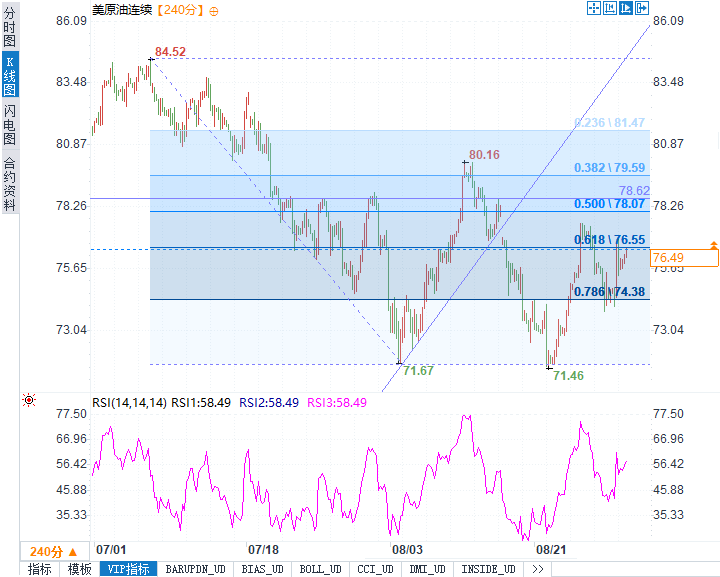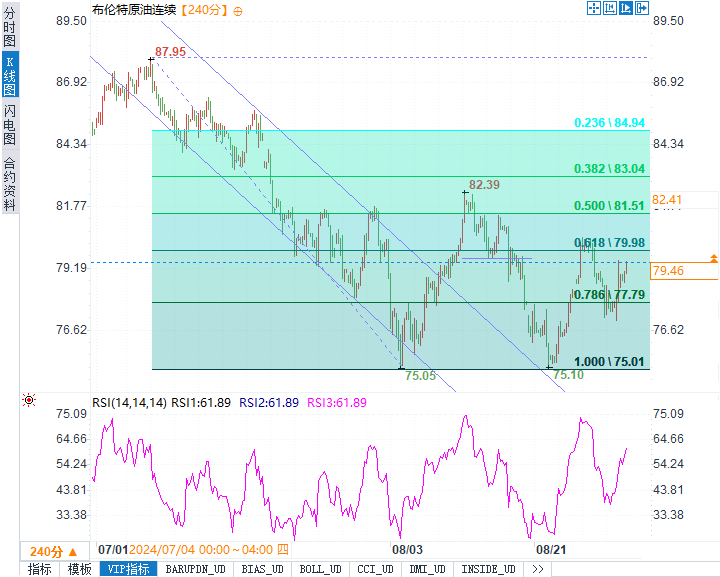Why is it difficult for oil prices to break through despite the crisis in the Middle East? What secrets are hidden behind it?
On Friday (August 30th), the global crude oil market experienced a rally, largely driven by supply concerns in Libya and Iraq. However, despite supply side concerns providing short-term price support, weak demand, especially weakened demand, remains the main factor suppressing the upward trend in oil prices.
As of 3:32 pm Beijing time on August 30th, the Brent crude oil October futures contract rose by $0.57, or 0.71%, to $80.51 per barrel. At the same time, the more actively traded November contract rose by $0.59, or 0.78%, to $79.43. The October futures contract for West Texas Intermediate (WTI) in the United States rose by $0.58, or 0.78%, to $76.48. Although Brent crude oil and WTI crude oil rose by 1.6% and 1.8% respectively this week, both crude oil futures have recorded two consecutive months of decline since August.
The rise in the crude oil market is mainly driven by supply side uncertainty. Priyanka Sachdeva, Senior Market Analyst at Phillip Nova, pointed out that the reduction in Libyan oil supply and Iraq's production cuts have amplified market concerns. The supply issues of these two Middle Eastern countries have further strained the global oil supply chain. Specifically, due to the confrontation between political factions, over half of Libya's oil production capacity (about 700000 barrels per day) was shut down on Thursday, and multiple ports have stopped exporting. According to a report by Rapidan Energy Group, Libya's production losses could reach 900000 to 1 million barrels per day and could last for several weeks.
On the other hand, Iraq also plans to reduce its oil production to 3.85 million to 3.9 million barrels per day in September. This news further exacerbates market concerns about the tight global oil supply.
However, despite the many uncertainties in the supply side, weak demand remains a key factor in curbing further increases in oil prices.
Technical analysis
From a technical perspective, WTI crude oil rose strongly in yesterday's trading, breaking through the key level of 76.86, but ultimately failed to stabilize above that level, leaving the risk of another decline still present. At present, there is a contradiction between technical indicators. It is recommended that investors continue to observe and wait until the market trend becomes clearer. Specifically, if WTI crude oil can break through and stabilize above 76.86, it is expected to further rise to 78.35; But if it falls below the support line of 75.00, it may trigger a new round of decline, and the target price will be between 73.90 and 73.00. The trading range for WTI crude oil today is expected to be between $74.9 and $78.5.

Brent crude oil is relatively strong, with its price breaking through 78.80 and stabilizing above that level, moving towards the initial target of testing $80.65. If we can break through this level, the next target will be $82.15. However, if Brent crude oil falls below 78.80 and remains below this level, it may face new downward pressure, and the short-term target price will retrace to $77.60 or even $75.80. The trading range for Brent crude oil today is expected to be between $78.5 and $81.5.

Market outlook
Although the tight supply situation in the short term has provided some support for oil prices, the market remains uncertain about the medium to long term prospects. Analysts from ANZ Bank mentioned in their latest report that the oil balance in 2025 looks quite weak. If demand remains weak, OPEC may have no choice but to postpone the gradual cancellation of voluntary production cuts to maintain oil price stability.
From the current market trend, crude oil prices may face dual pressures in the near future: on the one hand, supply issues in Libya and Iraq may support oil prices in the short term; On the other hand, the slowdown in global economic growth, especially in China, which suppresses demand, will limit the upward space for oil prices.
Overall, investors need to remain cautious in the current market environment. Although short-term supply issues may lead to fluctuations in oil prices, in the medium to long term, weak demand will continue to be the main factor driving the trend of oil prices. In this context, market sentiment is easily affected by sudden news, and it is recommended that investors closely monitor the economic data of major economies around the world and OPEC's next actions.
Tips:This page came from Internet, which is not standing for FXCUE opinions of this website.
Statement:Contact us if the content violates the law or your rights
